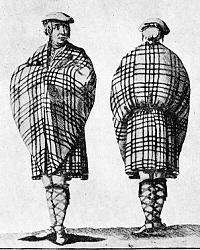A central question the project will need to address in the New Year is the costuming and appearance of Satyre‘s characters. Chief among these will be John the Commonwealth, and to do so, the team will first have to decide who, or even what, he is. Information in the play is hardly indicative. He bursts on to the stage much like the Pauper – “Out of my gate, for God’s sake let me ga!” (2422) – and yet does not suffer the abuse that Pauper does on the basis of his physical presentation, who is subjected to a litany of name-calling such as “False whoreson raggit carl” and told to leave “the field” (1946, 1939). So is John not “raggit” then? How does he demonstrate the necessary authority for Diligence to immediately smooth his path towards conference with the king (2434)? A significant sartorial transformation occurs when his suggested reforms are passed by Parliament at the end of the play and he is absorbed into them – “Here shall they clothe John the Commonweal gorgeously, and set him down amang them in the Parliament” (3802 s.d.). John now wears a “gay garmoon” but what did he wear before?
Jean E. Howard and Paul Strohm argue that John is the “indigenous voice of reform” in Ane Satyre and that both he and Pauper are “imagined from within, as internally self-regenerating forces”. Does this direct us towards some sort of native tradition of Scotland – tartan, kilts. etc – or perhaps even a connection with nature? John himself says that the commonwealth “want[s] clais” (2445). As it’s embodiment, does John too? Perhaps he occupies a similar position to the wild man of prose romance on the border between society and the wilderness, his liminal energy informing his ability to tell truth to power.
As a representation of the ‘commonwealth’, Carol Edington has argued against situating John in terms of class, rank or occupation, writing:
As much psychological and political, the ideal of the commonweal conveyed very real feelings of organic unity, physical dynamism, and a very emotive patriotism, Nowhere is this more vividly conveyed than in Lindsay’s dramatization of John the Commonweal. It should perhaps be stressed at this point that the character of John, despite his often hungry and ragged appearance, was not a symbolic representation of “the poor” or even, more specifically, of the rural poor. When Lindsay required such a figure he introduced the Pauper or the traditional “John Upland”. John the Commonweal on the other hand represents the universal and public good of the entire community and not the interests of any single element. He is the dramatic embodiment of a principle, not a party, an ideal and not an individual. (p120, my itals)
It is certainly true that if John is clothed as a member of the Scottish citizenry then this will have a knock-on effect in terms of all of the represented social relationships in the play, something we should be very wary of. But, for John to be “not an individual” is fine in theory, however theatre requires the practical expression of such interpretations. If John embodies a principle then how can that principle in turn be embodied? When the team gather at Stirling Castle early in 2013 to begin fixing aspects of the performance, such questions are sure to be hotly debated.
References:
Carol Edington, Court and Culture in Renaissance Scotland: Sir David Lindsay of the Mount, University of Massachusetts Press, 1994
Jean E. Howard and Paul Strohm, The Imaginary “Commons”, Journal of Medieval and Early Modern Studies, 37.3, 2007







